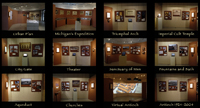
Duderstadt Gallery: Section 2 - Michigan's Expedition
In 1833, Francis V.J. Arundell, the British chaplain at Smyrna (modern Izmir), was the first modern traveler to identify and roughly map the ancient site of Pisidian Antioch. It was not until 1912, however, that excavations were undertaken by Sir William Ramsay of Edinburgh, Scotland. Ramsay’s team focused first on the sanctuary of the local deity, Mên Askaênos, but 1913-1914 they turned to the city of Antioch itself. With the outbreak of the First World War excavations ceased, to be taken up again in 1924 under the terms of a project developed by Francis W. Kelsey of the University of Michigan in cooperation with Ramsay, who still held the excavation permit. This was the first classical site ever excavated by the University. Michigan’s team was directed in the field by David M. Robinson of Johns Hopkins University. When the team arrived in Turkey in the spring of 1924 tension between Ramsay and Robinson arose almost immediately. Ramsay was interested in the inscriptions from the site virtually to the exclusion of the major buildings that his team had discovered in their earlier campaigns. He had, in fact, given the local workman explicit permission to haul off fallen architectural blocks belonging to the ancient structures for reuse in new construction in the town of Yalvaç. Robinson, while well aware of the importance of the inscriptions, was greatly concerned about the ongoing damage to the ancient buildings and the sculptures associated with them. Problems resulting from Ramsay’s and Robinson’s differing priorities and archaeological methodologies plagued the expedition, and Ramsay left the site a few weeks into the season. Work proceeded productively thereafter, but problems about the transfer of Ramsay’s permit to Michigan presented further difficulties. Ultimately Kelsey decided that the team should publish the important findings of the 1924 season before returning to excavate again in the spring of 1927. Meanwhile, Kelsey turned his attention to Karanis in Egypt and Carthage in Tunisia, where he started new excavation projects. Kelsey died in May of 1927, and it was not until 2004 that archaeologists from Michigan returned to Antioch again.
February 18, 2006
Digital Image
Courtesy of J. Matthew Harrington



